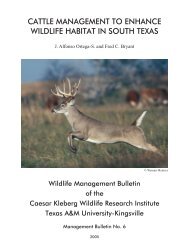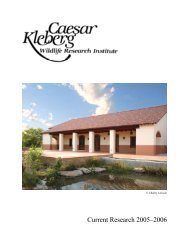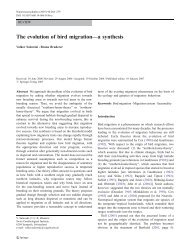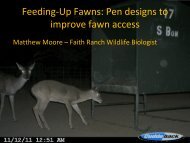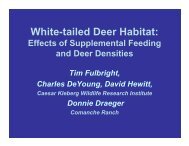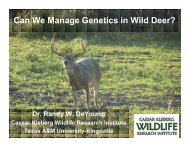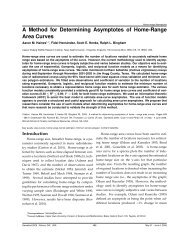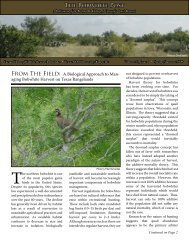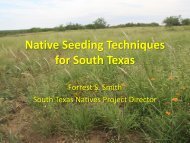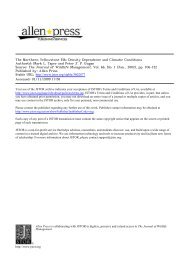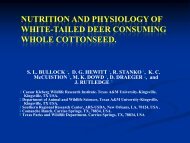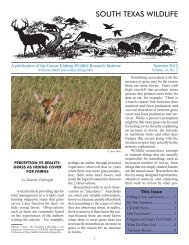South Texas Natives - Caesar Kleberg Wildlife Research Institute ...
South Texas Natives - Caesar Kleberg Wildlife Research Institute ...
South Texas Natives - Caesar Kleberg Wildlife Research Institute ...
You also want an ePaper? Increase the reach of your titles
YUMPU automatically turns print PDFs into web optimized ePapers that Google loves.
<strong>South</strong> <strong>Texas</strong> <strong>Natives</strong> Definitions:<br />
Revegetation - replanting plants for ecological, farm management or aesthetic purposes. Revegetation can increase<br />
the area of suitable habitat in the landscape, improve the quality of existing habitat, and help to link remnant or<br />
isolated habitats by providing ‘stepping stones’ and corridors.<br />
Restoration - the state of being restored to its former good condition, or the act of restoring something to a satisfactory<br />
state.<br />
Successional stage - A stage or recognizable condition of a plant community that occurs during its development<br />
from the bare ground to climax habitat. Recent theory points toward state and transitional models dealing with<br />
aggregations of co-specific plants whose abundance or occurrence is dictated by natural and man-induced disturbances.<br />
Invader - a species that has been introduced into an area beyond its native range. Invasions can result in losses of<br />
native species, changes in community structure and function, and alterations of the physical structure of the system.<br />
seed. Because chemical control of<br />
harmful insects also destroys populations<br />
of beneficial insects, care should<br />
be taken to ensure that harmful insect<br />
populations have reached a threshold<br />
where seed yield and quality or plant<br />
survival is negatively impacted before<br />
implementing chemical control. Severe<br />
infestations of harmful insects are often<br />
good indicators of other agronomic<br />
issues, such as poor plant health or<br />
vigor, low soil fertility, poor adaptation<br />
to the planting site, or environmental<br />
stresses, such as drought. Other times<br />
these harmful insect “booms” are a<br />
result of the large-scale production of<br />
native plant species that are typically<br />
less abundant or more widely distributed<br />
across the landscape in their native<br />
habitats. Irrigation of native plant<br />
stands for seed production in times of<br />
drought also influences harmful insect<br />
abundance. These irrigated stands<br />
often become the only food source for<br />
seed and plant eating insects, resulting<br />
in abnormal insect concentrations that<br />
must be controlled.<br />
In 2006, STN was faced with<br />
infestations of several insects. Thrips,<br />
tiny insects belonging to the order Thysanoptera,<br />
caused damage to sideoats<br />
grama (Bouteloua curtipendula), <strong>Texas</strong><br />
grama (B. rigidiseta), hairy grama (B.<br />
hirsuta var. hirsuta) and slender grama<br />
(B. repens). Plant-feeding thrips pierce<br />
a hole and suck out the contents of<br />
individual cells of leaves, flowers, and<br />
pollen causing a reduction in pollination<br />
and reduced seed fill (accumulation<br />
of food reserves). This, in turn,<br />
results in reduced seed production and<br />
reduced seed quality. The rice stink bug<br />
(Oebalus pugnax) infested our Arizona<br />
cottontop (Digitaria californica) and<br />
little bluestem (Schizachyrium scoparium)<br />
seed increase fields and our<br />
brownseed paspalum (Paspalum plicatulum)<br />
and pink pappusgrass (Pappophorum<br />
bicolor) evaluation plots.<br />
Rice stink bugs on Arizona cottontop<br />
The rice stink bug feeds on seeds with<br />
a piercing-sucking mouthpart called a<br />
proboscis. Nymphal and adult feeding<br />
removes the contents (the endosperm)<br />
from developing seeds during the milk<br />
and soft dough stages. We have also<br />
controlled fall armyworms (Spoloptera<br />
frugiperda) in Arizona cottontop and<br />
sideoats grama. These caterpillars<br />
occurred in large numbers following<br />
large rainfall events and at times when<br />
drought eliminated their other food<br />
sources. Armyworms will feed day<br />
and night on all above-ground plant<br />
© Forrest Smith<br />
7



